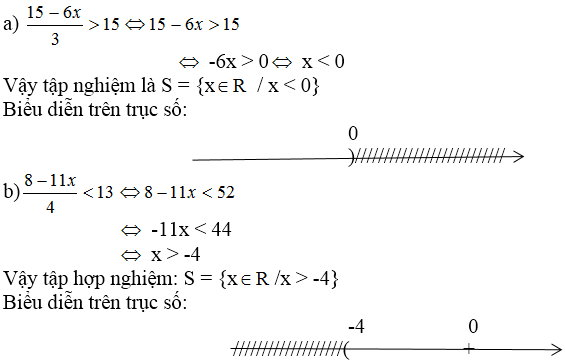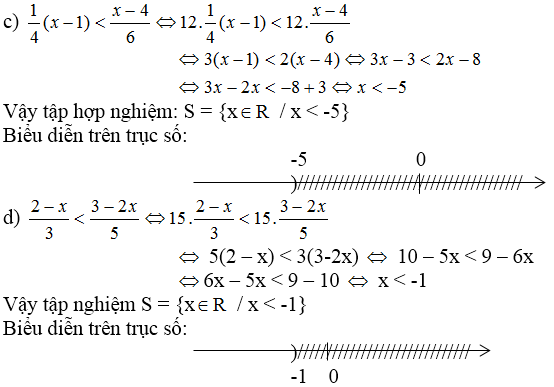Hãy nhập câu hỏi của bạn vào đây, nếu là tài khoản VIP, bạn sẽ được ưu tiên trả lời.

3) 9h30phút-30phút=9h
Gọi x(km) là quãng đường từ A đến B (ĐK X>0)
Thời gian xe đi từ A đến B là \(\dfrac{X}{15}\)(h)
Thời gian xe đi từ B đến A là \(\dfrac{X}{12}\)(h)
Theo đề bài ta có phương trình :
\(\dfrac{x}{15}+\dfrac{x}{12}=9\)
Giải pt:\(\dfrac{X}{15}+\dfrac{x}{12}=9\Leftrightarrow\dfrac{4x}{60}+\dfrac{5x}{60}=\dfrac{540}{60}\Rightarrow4x+5x=540\Leftrightarrow9x=540\Leftrightarrow x=60\)
Vậy quãng đường từ A đến B là 60 km
\(15x-3\left(3x-2\right)=45-5\left(2x-5\right)\Leftrightarrow15x-9x+6=45-10x+25\Leftrightarrow16x=64\Leftrightarrow x=4\)

Câu 3:
Gọi quãng đường AB là x ( km, x>0)
Thời gian lúc đi là: \(\dfrac{x}{30}h\)
Thời gian lúc về là: \(\dfrac{x}{40}h\)
45' = \(\dfrac{3}{4}h\)
Theo đề ra ta có pt:
\(\dfrac{x}{30}-\dfrac{3}{4}=\dfrac{x}{40}\)
\(\Leftrightarrow4x-90=3x\)
\(\Leftrightarrow x=90\) ( nhận)
Vậy quẵng đường AB dài 90 km

a: \(\Leftrightarrow20x^2-12x+15x+5< 10x\left(2x+1\right)-30\)
\(\Leftrightarrow20x^2+3x+5< 20x^2+10x-30\)
=>3x+5<10x-30
=>-7x<-35
hay x>5
b: \(\Leftrightarrow4\left(5x-20\right)-6\left(2x^2+x\right)>4x\left(1-3x\right)-15x\)
\(\Leftrightarrow20x-80-12x^2-6x>4x-12x^2-15x\)
=>14x-80>-11x
=>25x>80
hay x>16/5

3.
- Gọi x(km) là quãng đường AB ( x > 0 )
- Thời gian đi:\(\dfrac{x}{60}\) (h)
- Thời gia về:\(\dfrac{x}{50}\) (h)
Ta có phương trình
\(\dfrac{x}{50}\) - \(\dfrac{x}{60}\) = \(\dfrac{4}{5}\)
\(\Leftrightarrow\) 6x - 5x = 240
\(\Leftrightarrow\) x = 240 (TM)
Vậy quãng đường AB là 240km

Câu 3:
\(\Leftrightarrow3x^3-2x^2+6x^2-4x+9x-6>0\)
\(\Leftrightarrow\left(3x-2\right)\left(x^2+2x+3\right)>0\)
=>3x-2>0
=>x>2/3
Câu 1:
a: \(A=x-2+\dfrac{6x-3}{x\left(x+2\right)}+\left(\dfrac{x+1+2x-2}{\left(x^2-1\right)}-\dfrac{3}{x}\right)\cdot\dfrac{x^2-1}{x+2}\)
\(=x-2+\dfrac{6x-3}{x\left(x+2\right)}+\left(\dfrac{3x-1}{x^2-1}-\dfrac{3}{x}\right)\cdot\dfrac{x^2-1}{x+2}\)
\(=x-2+\dfrac{6x-3}{x\left(x+2\right)}+\dfrac{3x^2-x-3x^2+3}{x\left(x^2-1\right)}\cdot\dfrac{x^2-1}{x+2}\)
\(=x-2+\dfrac{6x-3}{x\left(x+2\right)}+\dfrac{-\left(x-3\right)}{x\left(x+2\right)}\)
\(=x-2+\dfrac{6x-3-x^2+3x}{x\left(x+2\right)}\)
\(=x-2+\dfrac{-x^2+9x-3}{x\left(x+2\right)}\)
\(=\dfrac{x\left(x^2-4\right)-x^2+9x-3}{x\left(x+2\right)}\)
\(=\dfrac{x^3-4x-x^2+9x-3}{x\left(x+2\right)}\)
\(=\dfrac{x^3-x^2+5x-3}{x\left(x+2\right)}\)
b: TH1: \(\left\{{}\begin{matrix}x^3-x^2+5x-3>0\\x\left(x+2\right)< 0\end{matrix}\right.\Leftrightarrow\left\{{}\begin{matrix}-2< x< 2\\x>0.63\end{matrix}\right.\Leftrightarrow0.63< x< 2\)
TH2: \(\left\{{}\begin{matrix}x^3-x^2+5x-3< 0\\x\left(x+2\right)>0\end{matrix}\right.\Leftrightarrow\left\{{}\begin{matrix}x< 0.63\\\left[{}\begin{matrix}x>0\\x< -2\end{matrix}\right.\end{matrix}\right.\Leftrightarrow\left[{}\begin{matrix}0< x< 0.63\\x< -2\end{matrix}\right.\)

A/ \(2\left(5x-3\right)=7x-18.\)
\(10x-6=7x-18\)
\(10-7x=6-18\)
\(3x=-12\)
\(x=-\frac{12}{3}=4\)
\(\Rightarrow S=\left\{4\right\}\)
B/ \(3x\left(x-2\right)+2x-4=0\)
\(3x\left(x-2\right)+2\left(x-2\right)=0\)
\(\left(x-2\right)\left(3x+2\right)=0\)
\(\orbr{\begin{cases}x-2=0\Rightarrow x=2\\3x+2=0\Rightarrow3x=-2\Rightarrow x=-\frac{2}{3}\end{cases}}\)
\(\Rightarrow S=\left\{2;-\frac{2}{3}\right\}\)
C/ \(\frac{x+2}{3}\frac{x-3}{2}=\frac{x+5}{4}\)
\(\frac{\left(x+2\right)\left(x-3\right)}{3.2}=\frac{x+5}{4}\)
\(\frac{x^2-3x+2x-6}{6}=\frac{x+5}{4}\)
\(\frac{x^2-x-6}{6}=\frac{x+5}{4}\)
\(\frac{2\left(x^2-x-6\right)}{12}=\frac{3\left(x+5\right)}{12}\)
\(\frac{2x^2-2x-12}{12}=\frac{3x+15}{12}\)
\(\Rightarrow2x^2-2x-12=3x+15\)
(chuyển vế r làm tiếp)
Bài 1 :
\(a,2\left(5x-3\right)=7x-18\)
\(\Leftrightarrow10x-6=7x-18\)
\(\Leftrightarrow10x-7x=6-18\)
\(\Leftrightarrow3x=-12\)
\(\Leftrightarrow x=-4\)
PT có nghiệm S = { -4 }
\(b,3x\left(x-2\right)+2x-4=0\)
\(\Leftrightarrow3x^2-6x+2x-4=0\)
\(\Leftrightarrow3x^2-4x-4=0\)
\(\Leftrightarrow3x^2-6x+2x-4=0\)
\(\Leftrightarrow3x\left(x-2\right)+2\left(x-2\right)=0\)
\(\Leftrightarrow\left(3x+2\right)\left(x-2\right)=0\)
\(\Rightarrow\orbr{\begin{cases}3x+2=0\\x-2=0\end{cases}}\Rightarrow\orbr{\begin{cases}x=\frac{-2}{3}\\x=2\end{cases}}\)
KL : ............
\(c,\frac{x+2}{3}-\frac{x-3}{2}=\frac{x+5}{4}\)
\(\Leftrightarrow\frac{4\left(x+2\right)}{12}-\frac{6\left(x-3\right)}{12}=\frac{3\left(x+5\right)}{12}\)
\(\Leftrightarrow4x+8-6x+18=3x+15\)
\(\Leftrightarrow4x-6x-3x=-8-18+15\)
\(\Leftrightarrow x=-9\)
KL : .......

a) \(3\left(4x-1\right)-2x\left(5x+2\right)>8x-2\)
\(\Leftrightarrow12x-3-10x^2-4x>8x-2\)
\(\Leftrightarrow-10x^2>5\)
\(\Leftrightarrow x^2< \dfrac{-1}{2}\)(vô lí)
Vậy bất phương trình đã cho vô nghiệm.
h)
\(\dfrac{x+5}{x+7}-1>0\)
\(\Leftrightarrow\dfrac{x+5}{x+7}-\dfrac{x+7}{x+7}>0\)
\(\Leftrightarrow\dfrac{x+5-x-7}{x+7}>0\)
\(\Leftrightarrow\dfrac{-2}{x+7}>0\)
\(\Leftrightarrow x+7< 0\)
\(\Leftrightarrow x< -7\)
g)
\(\dfrac{4-x}{3x+5}\ge0\)
* TH1:
\(4-x\ge0\) và \(3x+5>0\)
\(\Leftrightarrow x\le4\) và \(x>\dfrac{-5}{3}\)
* TH2:
\(4-x\le0\) và \(3x+5< 0\)
\(\Leftrightarrow x\ge4\) và \(x< \dfrac{-5}{3}\) ( loại)
Vậy: \(-\dfrac{5}{3}< x\le4\)

Giải các phương trình
\(a,3x-2=2x-3\)
\(\Leftrightarrow3x-2x=-3+2\)
\(\Leftrightarrow x=-1\)
Vậy pt có tập nghiệm S = { - 1 }
\(b,2x+3=5x+9\)
\(\Leftrightarrow2x-5x=9-3\)
\(\Leftrightarrow-3x=6\)
\(\Leftrightarrow x=-2\)
Vậy pt có tập nghiệm S = { - 2 }
\(c,11x+42-2x=100-9x-22\)
\(\Leftrightarrow11x-2x+9x=100-22-42\)
\(\Leftrightarrow18x=36\)
\(\Leftrightarrow x=2\)
Vậy pt có tập nghiệm S = { - 2 }
\(d,2x-\left(3-5x\right)=4\left(x+3\right)\)
\(\Leftrightarrow2x-3+5x=4x+12\)
\(\Leftrightarrow2x+5x-4x=12+3\)
\(\Leftrightarrow3x=15\)
\(\Leftrightarrow x=5\)
Vậy pt có tập nghiệm S = { - 5 }
\(e,\dfrac{3x+2}{2}-\dfrac{3x+1}{6}=\dfrac{5}{3}+2x\)
\(\Leftrightarrow\dfrac{3\left(3x+2\right)}{6}-\dfrac{3x+1}{6}=\dfrac{5.2}{6}+\dfrac{2x.6}{6}\)
\(\Leftrightarrow9x+6-3x-1=10+12x\)
\(\Leftrightarrow9x-3x-12x=10-6+1\)
\(\Leftrightarrow-6x=5\)
\(\Leftrightarrow x=-\dfrac{5}{6}\)
Vậy pt có tập nghiệm S = { - \(\dfrac{5}{6}\) }
f,\(\dfrac{x+4}{5}-x+4=\dfrac{x}{3}-\dfrac{x-2}{2}\)
\(\Leftrightarrow\dfrac{6\left(x+4\right)}{30}-\dfrac{30x}{30}+\dfrac{4.30}{30}=\dfrac{10x}{30}-\dfrac{15\left(x-2\right)}{30}\)
\(\Leftrightarrow6x+24-30x+120=10x-15x+30\)
\(\Leftrightarrow6x-30x-10x+15x=30-24-120\)
\(\Leftrightarrow-19x=-114\)
\(\Leftrightarrow x=6\)
Vậy pt có tập nghiệm S = { - 6 }
\(g,\left(2x+1\right)\left(x-1\right)=0\)
\(\Leftrightarrow\left[{}\begin{matrix}2x+1=0\\x-1=0\end{matrix}\right.\Leftrightarrow\left[{}\begin{matrix}x=-\dfrac{1}{2}\\x=1\end{matrix}\right.\)
Vậy pt có tập nghiệm S = { \(1;-\dfrac{1}{2}\) }
\(h,\left(x+\dfrac{2}{3}\right)\left(x-\dfrac{1}{2}\right)=0\)
\(\Leftrightarrow\left[{}\begin{matrix}x+\dfrac{2}{3}=0\\x-\dfrac{1}{2}=0\end{matrix}\right.\Leftrightarrow\left[{}\begin{matrix}x=-\dfrac{2}{3}\\x=\dfrac{1}{2}\end{matrix}\right.\)
Vậy pt có tập nghiệm S = { \(-\dfrac{2}{3};\dfrac{1}{2}\) }
\(i,\left(3x-1\right)\left(2x-3\right)\left(2x-3\right)\left(x+5\right)=0\)
\(\Leftrightarrow\left(3x-1\right)\left(2x-3\right)^2\left(x+5\right)=0\)
\(\Leftrightarrow\left[{}\begin{matrix}3x-1=0\\2x-3=0\\x+5=0\end{matrix}\right.\Leftrightarrow\left[{}\begin{matrix}x=\dfrac{1}{3}\\x=\dfrac{3}{2}\\x=-5\end{matrix}\right.\)
Vậy pt có tập nghiệm S = { \(\dfrac{1}{3};\dfrac{3}{2};-5\) }
\(k,3x-15=2x\left(x-5\right)\)
\(\Leftrightarrow3x-15=2x^2-10x\)
\(\Leftrightarrow-2x^2+3x+10x=15\)
\(\Leftrightarrow-2x^2+13x-15=0\)
\(\Leftrightarrow-2x^2+10x+3x-15=0\)
\(\Leftrightarrow\left(x-5\right)\left(3-2x\right)=0\)
\(\Leftrightarrow\left[{}\begin{matrix}x-5=0\\3-2x=0\end{matrix}\right.\Leftrightarrow\left[{}\begin{matrix}x=5\\x=\dfrac{3}{2}\end{matrix}\right.\)
Vậy pt có tập nghiệm S = { \(5;\dfrac{3}{2}\) }
\(m,\left|x-2\right|=3\)
\(\Leftrightarrow\left[{}\begin{matrix}x-2=3\\x-2=-3\end{matrix}\right.\Leftrightarrow\left[{}\begin{matrix}x=5\\x=-1\end{matrix}\right.\)
Vậy pt có tập nghiệm S = { -1; 5 }
\(n,\left|x+1\right|=\left|2x+3\right|\)
\(\Leftrightarrow\left[{}\begin{matrix}x+1=2x+3\\x+1=-2x-3\end{matrix}\right.\)
\(\Leftrightarrow\left[{}\begin{matrix}x=-2\\x=-\dfrac{4}{3}\end{matrix}\right.\)
Vậy pt có tập nghiệm S = { \(-2;-\dfrac{4}{3}\) }
\(j,\dfrac{7x-3}{x-1}=\dfrac{2}{3}\) ĐKXĐ : x≠ 1
\(\Leftrightarrow3\left(7x-3\right)=2\left(x-1\right)\)
\(\Leftrightarrow21x-9=2x-2\)
\(\Leftrightarrow x=\dfrac{7}{19}\) ( t/m )
Vậy pt có tập nghiệm S = { \(\dfrac{7}{19}\) }
đ, ĐKXĐ : x ≠ - 1
\(\dfrac{2\left(3-7x\right)}{1+x}=\dfrac{1}{2}\)
\(\Leftrightarrow4\left(3-7x\right)=1+x\)
\(\Leftrightarrow12-28x=1+x\)
\(\Leftrightarrow-29x=-11\)
\(\Leftrightarrow x=\dfrac{11}{29}\) ( t/m)
Vậy pt có tập nghiệm S = { \(\dfrac{11}{29}\) }
\(y,\dfrac{x+5}{x-5}-\dfrac{x-5}{x+5}=\dfrac{20}{x^2-25}\) ĐKXĐ : \(\left\{{}\begin{matrix}x\ne5\\x\ne-5\end{matrix}\right.\)
\(\Leftrightarrow\dfrac{\left(x+5\right)^2-\left(x-5\right)^2}{\left(x-5\right)\left(x+5\right)}=\dfrac{20}{\left(x-5\right)\left(x+5\right)}\)
\(\Rightarrow20x=20\)
\(\Leftrightarrow x=1\) ( t/m )
Vậy pt có tập nghiệm S = { 1 }
\(\dfrac{1}{x-1}+\dfrac{2}{x+1}=\dfrac{x}{x^2-1}\) ĐKXĐ : \(\left\{{}\begin{matrix}x\ne1\\x\ne-1\end{matrix}\right.\)
\(\Leftrightarrow\dfrac{x+1+2\left(x-1\right)}{\left(x-1\right)\left(x+1\right)}=\dfrac{x}{\left(x-1\right)\left(x+1\right)}\)
\(\Rightarrow3x-1=x\)
\(\Leftrightarrow2x=1\Leftrightarrow x=\dfrac{1}{2}\)( t/m)
Vậy pt có tập nghiệm S = { \(\dfrac{1}{2}\) }

Bài 1:
Áp dụng BĐt cauchy dạng phân thức:
\(\dfrac{1}{2x+y}+\dfrac{1}{x+2y}\ge\dfrac{4}{3\left(x+y\right)}\)
\(\Rightarrow\left(3x+3y\right)\left(\dfrac{1}{2x+y}+\dfrac{1}{x+2y}\right)\ge\left(3x+3y\right).\dfrac{4}{3x+3y}=4\)
dấu = xảy ra khi 2x+y=x+2y <=> x=y
Bài 2:
ta có: \(\dfrac{1}{a}+\dfrac{1}{b}+\dfrac{1}{c}+\dfrac{1}{d}\ge\dfrac{4^2}{a+b+c+d}=\dfrac{16}{a+b+c+d}\)(theo BĐt cauchy-schwarz)
\(\Rightarrow\dfrac{1}{a+b+c+d}\le\dfrac{1}{16}\left(\dfrac{1}{a}+\dfrac{1}{b}+\dfrac{1}{c}+\dfrac{1}{d}\right)\)
Áp dụng BĐT trên vào bài toán ta có:
\(A=\dfrac{1}{2a+b+c}+\dfrac{1}{a+2b+c}+\dfrac{1}{a+b+2c}\le\dfrac{1}{16}\left(\dfrac{2}{a}+\dfrac{1}{b}+\dfrac{1}{c}+\dfrac{1}{a}+\dfrac{2}{b}+\dfrac{1}{c}+\dfrac{1}{a}+\dfrac{1}{b}+\dfrac{2}{c}\right)\)\(A\le\dfrac{1}{16}.4\left(\dfrac{1}{a}+\dfrac{1}{b}+\dfrac{1}{c}\right)=\dfrac{1}{4}\left(\dfrac{1}{a}+\dfrac{1}{b}+\dfrac{1}{c}\right)\)
......
dấu = xảy ra khi a=b=c
Bài 2:
Áp dụng BĐT cauchy cho 2 số dương:
\(a^2+1\ge2a\)
\(\Leftrightarrow\dfrac{a}{a^2+1}\le\dfrac{a}{2a}=\dfrac{1}{2}\)
thiết lập tương tự:\(\dfrac{b}{b^2+1}\le\dfrac{1}{2};\dfrac{c}{c^2+1}\le\dfrac{1}{2}\)
cả 2 vế các BĐT đều dương ,cộng vế với vế,ta có dpcm
dấu = xảy ra khi a=b=c=1

